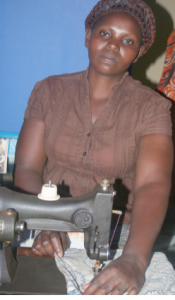It is often the case that the hardest and most expensive places to reach are where the greatest need exists. P4P works to surmount obstacles—both physical and financial—that stand in the way of isolated regions realizing economic success. Since 2006, we have measured our success in helping Ugandans develop economic independence by noting the increased demand for the delivery of bicycles. Now, through our existing partnership with the Entrepreneurship Institute of Applied and Appropriate Technology (EIAAT), which receives and distributes our shipments, we have included sewing machines along with the bicycles and extended more opportunities to more Ugandans.
Of course, this is not as simple as it sounds. Uganda is among the most expensive places to ship. Getting from here through the Suez Canal to Mombasa Kenya is relatively reasonable, but our vessel, the Maersk Alabama, was recently attacked again by pirates. Trucking containers inland across thousands of miles from Mombasa Kenya to Kampala Uganda on bad roads is much more expensive than maneuvering within pirate-infested shipping lanes. We funded the most recent shipment with grants from the Helen & William Mazer Foundation and the Clif Bar Family Foundation.

The courageous hard working Jane Kigoye is just one example of how the inclusion of sewing machines in these shipments has begun to change lives for the better. Jane had no employment and worked as best she could in her garden for food. Sometimes she could find beans, nuts, and other cereals and she improvised as best she could. Her husband’s job as a motor vehicle mechanic did not bring in enough money to keep their four children from hunger. Jane did have some knowledge about basic tailoring; all she needed was a reliable sewing machine. As is often the case, necessity breeds innovation and she managed to search out and hire a manual sewing machine and a small shop to operate from. When she made some money, she made some inquiries in Kampala about the cost of sewing machines. From there she was directed to the EIAAT by one of the agents who buys bicycles from them. She went to the institute and, after looking at the various electric sewing machines, selected one. They told her that it cost $85 but, after some bargaining, they settled on $80. She only had $40, so she left that as a deposit and had to leave the sewing machine behind, promising to pay $10 from what she made from the tailoring every week.
During this time she was mastering the art of tailoring and the income she was making was used partly for home provisions and partly for her weekly payments on the sewing machine. As her business grew, she was no longer digging in the garden and she was able to hire casual labor to take the manual chores over. All her efforts were on growing her tailoring business and creating a stable life for her children. This may all sound rather charmed, but it was not an easy path that led to full stomachs and financial security. A major setback occurred after only two weeks of payments.
She arrived at the EIAAT almost in tears telling them that the sewing machine she had hired was taken away from her and she did not know what to do. Inevitably, if she lost her tailoring shop, somebody would readily move in and take over her customers. Getting a new place is very expensive. She would need to be able to pay for three to four months’ rent at once, plus the fee for the house “blocker” who finds the place for her. She would also have to furnish the new place and develop new clients.
| COUNTRY FACTS: UGANDA POPULATION: 25 MILLION GDP PER CAPITA: $1,200 per year LITERACY RATE: 70% |
